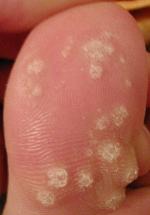Related Research Articles

Warts are non-cancerous viral growths usually occurring on the hands and feet but can also affect other locations, such as the genitals or face. One or many warts may appear. They are distinguished from cancerous tumors as they are caused by a viral infection, such as a human papillomavirus, rather than a cancerous growth.

A plantar wart, or verruca vulgaris, is a wart occurring on the bottom of the foot or toes. Its color is typically similar to that of the skin. Small black dots often occur on the surface. One or more may occur in an area. They may result in pain with pressure such that walking is difficult.

An eschar is a slough or piece of dead tissue that is cast off from the surface of the skin, particularly after a burn injury, but also seen in gangrene, ulcer, fungal infections, necrotizing spider bite wounds, tick bites associated with spotted fevers and exposure to cutaneous anthrax. The term ‘eschar’ is not interchangeable with ‘scab’. An eschar contains necrotic tissue whereas a scab is composed of dried blood and exudate.

A seborrheic keratosis is a non-cancerous (benign) skin tumour that originates from cells, namely keratinocytes, in the outer layer of the skin called the epidermis. Like liver spots, seborrheic keratoses are seen more often as people age.

Tuberculosis verrucosa cutis is a rash of small, red papules and nodules in the skin that may appear two to four weeks after inoculation by Mycobacterium tuberculosis in a previously infected and immunocompetent individual.

Imiquimod, sold under the brand name Aldara among others, is a medication that acts as an immune response modifier that is used to treat genital warts, superficial basal cell carcinoma, and actinic keratosis. Scientists at 3M's pharmaceuticals division discovered the drug and 3M obtained the first FDA approval in 1997. As of 2015, imiquimod is generic and is available worldwide under many brands.

Angiokeratoma is a benign cutaneous lesion of capillaries, resulting in small marks of red to blue color and characterized by hyperkeratosis. Angiokeratoma corporis diffusum refers to Fabry's disease, but this is usually considered a distinct condition.

The parotoid gland is an external skin gland on the back, neck, and shoulder of some frogs, and salamanders. It can secrete a number of milky alkaloid substances known collectively as bufotoxins, which act as neurotoxins to deter predation. These cutaneous glands are called parotoid as they are somewhat similarly positioned to mammalian parotid gland, although the latter have a different function, excreting saliva within the mouth rather than externally excreted defensive chemicals.

The Koebner phenomenon or Köbner phenomenon, also called the Koebner response or the isomorphic response, attributed to Heinrich Köbner, is the appearance of skin lesions on lines of trauma. The Koebner phenomenon may result from either a linear exposure or irritation. Conditions demonstrating linear lesions after a linear exposure to a causative agent include: molluscum contagiosum, warts and toxicodendron dermatitis. Warts and molluscum contagiosum lesions can be spread in linear patterns by self-scratching ("auto-inoculation"). Toxicodendron dermatitis lesions are often linear from brushing up against the plant. Causes of the Koebner phenomenon that are secondary to scratching rather than an infective or chemical cause include vitiligo, psoriasis, lichen planus, lichen nitidus, pityriasis rubra pilaris, and keratosis follicularis.

Hyper IgM Syndrome Type 1 (HIGM-1) is the X-linked variant of the hyper IgM syndrome.

Epidermodysplasia verruciformis (EV) is a skin condition characterised by warty skin lesions. It results from an abnormal susceptibility to HPV infection (HPV) and is associated with a high lifetime risk of squamous cell carcinomas in skin. It generally presents with scaly spots and small bumps particularly on the hands, feet, face and neck; typically beginning in childhood or in a young adult. The bumps tend to be flat, grow in number and then merge to form plaques. On the trunk, it typically appears like pityriasis versicolor; lesions there being slightly scaly and tan, brown, red or looking pale. On the elbows, it may appear like psoriasis. On the forehead, neck and trunk, the lesions may appear like seborrheic keratosis.
Condylomata lata or condyloma latum, is a cutaneous condition characterized by wart-like lesions on the genitals. They are generally symptoms of the secondary phase of syphilis, caused by the spirochete, Treponema pallidum.

Cutaneous horns, also known by the Latin name cornu cutaneum, are unusual keratinous skin tumors with the appearance of horns, or sometimes of wood or coral. Formally, this is a clinical diagnosis for a "conical projection above the surface of the skin." They are usually small and localized but can, in very rare cases, be much larger. Although often benign, they can also be malignant or premalignant.
Florid cutaneous papillomatosis (FCP), is an obligate paraneoplastic syndrome.

Elephantiasis nostras, is a disease that usually affects the lower legs or scrotum. Swelling is accompanied by rough nodules or wart-like plaques on the skin. If the disease is not treated, it eventually results in pain and immobility.
Pigmented warts are a cutaneous condition commonly reported in Japan, most often occurring on the hands or feet.

Giant condyloma acuminatum is a rare cutaneous condition characterized by an aggressive, wart-like growth that is a verrucous carcinoma. It is attributed to human papillomavirus.
Pseudoepitheliomatous keratotic and micaceous balanitis is a cutaneous condition characterized by skin lesions on the glans penis that are wart-like with scaling.
A trumpeter's wart is a cutaneous condition characterized by a firm, fibrous, hyperkeratotic nodule on the upper lip of a trumpet player.
Butcher's wart is a wart on the hands of butchers. They tend to occur in multiple numbers. These warts are generally larger than common warts.
References
- ↑ Rapini, Ronald P.; Bolognia, Jean L.; Jorizzo, Joseph L. (2007). Dermatology: 2-Volume Set. St. Louis: Mosby. pp. 1187–8. ISBN 1-4160-2999-0.